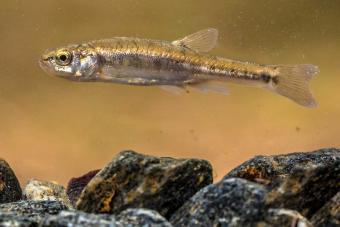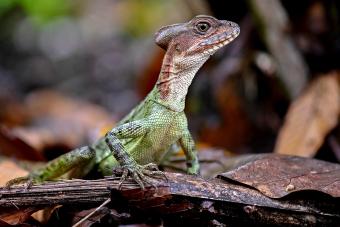
If you're considering adopting a salamander as a pet, you'll want to know what to feed salamanders. Salamanders make excellent pets and are surprisingly easy to care for when properly understood. While they are very easy to feed with the proper knowledge, there are actions that can be taken to avoid overfeeding and maintain optimal nutrition.
Salamander Diet
The diet of your salamander will correlate with their natural habitat. The diet of a land-dwelling salamander, also known as a terrestrial salamander, is likely to differ from a salamander living in a more aquatic environment.
Land Salamanders
Salamanders that are primarily land-dwelling frequently consume a diet consisting of worms and bugs that can be found nearby. In captivity, they should be provided crickets, mealworms, and earthworms. A combination will provide your salamander with adequate nutrition. Mealworms, for example, don't provide adequate nutrition, nor do waxworms, so providing variety will fill in the nutritional gaps.
Aquatic Salamanders

Unlike land-dwelling salamanders, aquatic salamanders are less likely to consume a diet consisting of bugs. Instead, they are more likely to consume brine shrimp, minnows, crayfish, and other small organisms that can be found within the water they live in. For aquatic salamanders in captivity, you can purchase minnows and brine shrimp to satisfy their nutritional requirements.
How to Feed Your Salamander
Whether you have an aquatic or land-dwelling salamander, they will prefer to consume live food rather than dead or artificial foods, such as pellets. The Fire Salamander is an exception. They don't mind dead food and can be fed from trays.
Although it's tempting to find bugs outside, they could carry parasites or may have been exposed to chemicals, such as pesticides or herbicides. Instead of feeding wild-caught organisms, purchase your salamander's food from your local pet store. You can also contact your local bait shop and ask if their bait has been altered in any aspect. If it hasn't been altered with attractants, this is another option to source.
Preparing the Food
Prior to offering the food to your salamander, it's important to conduct a process known as gut-loading. This involves feeding the insects for several days prior to offering them to your salamander. Gut loading ensures the organisms you are feeding your salamander are full of nutrients.
Amount and Frequency
Salamanders should be fed two to three times per week at night due to their nocturnal nature. They generally don't eat on a daily basis in the wild. Mimicking their natural environment with their natural routine will keep them as healthy as possible. If you are concerned with how much to feed or how often to feed, you can contact your local exotic veterinarian or expert herpetologist.
Only give the amount of food your salamander can consume within 30 minutes. Observe your salamander the first several times they eat and determine how much they eat before ending their feeding session.
What to Avoid

Some salamander owners may attempt to feed their salamander food that can be found in the kitchen. Salamanders should never be fed meat, fruits, or vegetables. As a general guideline, don't feed your salamander any item that cannot be naturally found in their native habitat.
You should also never leave uneaten food in your salamander's habitat, regardless of if they are land-dwelling or aquatic. Bugs left in your salamander's tank can attack the salamander when they aren't hungry or cause irritation to their skin. Aquatic organisms can also lead to water contamination or bacteria formation within the salamander's environment.
There are also several insect types that are toxic or dangerous to salamanders. These include:
- Spiders
- Ticks
- Centipedes
- Millipedes
Supplements for Salamanders
Salamanders can benefit from a multivitamin provided once or twice per week. If you are feeding crickets, you can coat the crickets with the supplement prior to feeding. If you do provide a supplement, it should never contain Vitamin D3. Vitamin D3 is toxic to salamanders at high levels and can be fatal.
Hydrating Your Salamander
You likely won't notice your land-dwelling salamander lapping up water as you would with other organisms. Salamanders soak water into their bodies through their skin so it's more likely you will see a land-dwelling salamander in a moist area of their habitat or in the water bowl for brief periods of time. Using a water bottle to mist their substrate is recommended.
Problems Feeding Salamanders
Although feeding salamanders is generally simple once you understand what to feed, they are sometimes hesitant to eat, making care for them more difficult. If you are observing your salamander when you release food into their habitat and they aren't eating, you can try feeding them yourself. Some salamanders will eat when food is presented to them. To present the food, place the live bug in a pair of tweezers and present it to your pet. Wait patiently for the salamander to eat the food.
Food-related Health Conditions
Like other pets, if your salamander does not receive adequate nutrition, health problems are likely to develop. The most notable is metabolic bone disease, which is caused by a lack of calcium. A diet that is not appropriate can also result in a weak immune system, making your salamander more prone to developing an infection.
Feeding a Baby Salamander
If you have a baby salamander, you can rest easy knowing they are also often easy to feed. They are generally less picky than adults, although their size may make feeding slightly more difficult. After hatching, they will consume the remnants of their shell. This will keep them satisfied for several days until they begin eating plankton and other small organisms found in the water.
Once they reach approximately 2 weeks old, they transition from eating plankton to eating small aquatic insects, such as mosquito larvae.
Do Your Research
When you purchase your salamander, consult with the breeder or pet store about which foods they have been feeding your pet and how often. It is best to keep the diet as similar as possible and introduce new foods slowly for a successful transition to a new home. Prior to bringing your pet home, do the research on your individual species to determine if they have any special feeding requirements.







